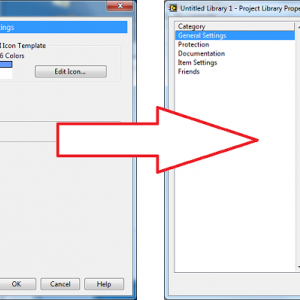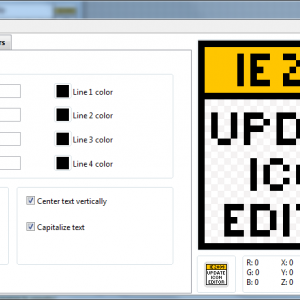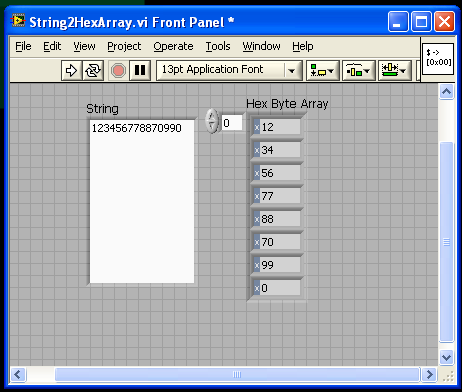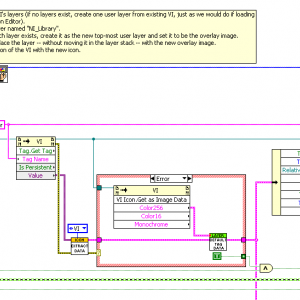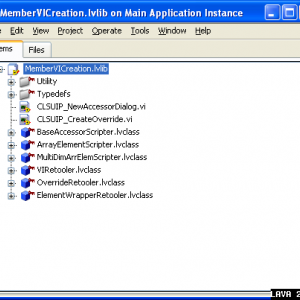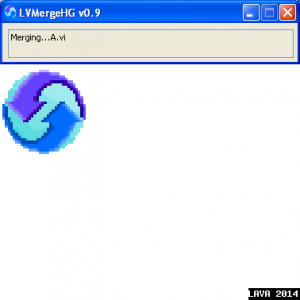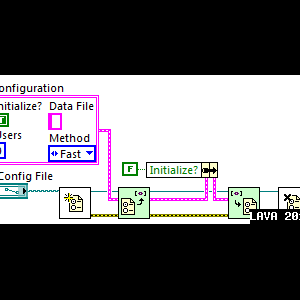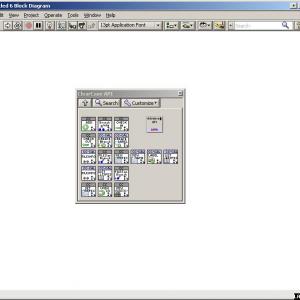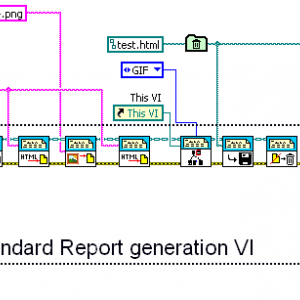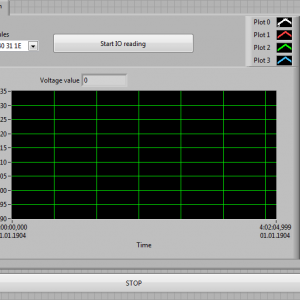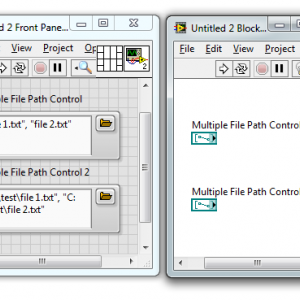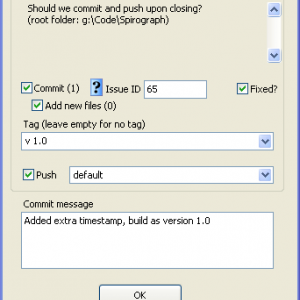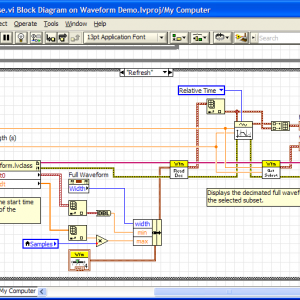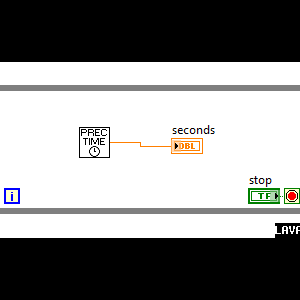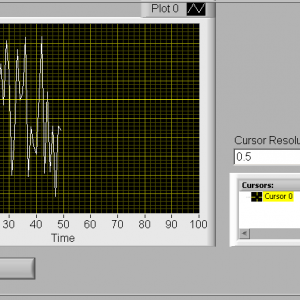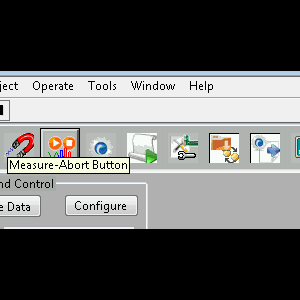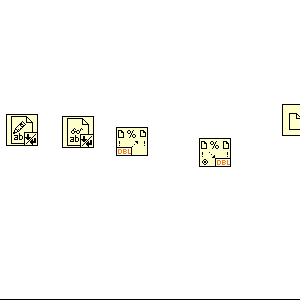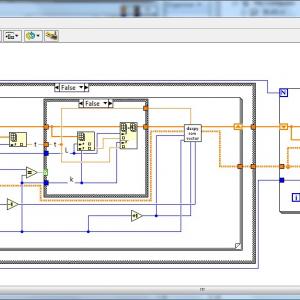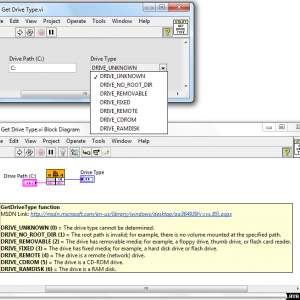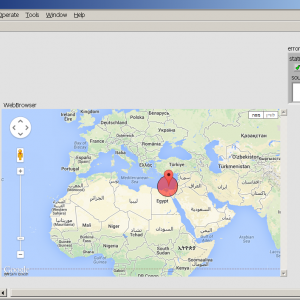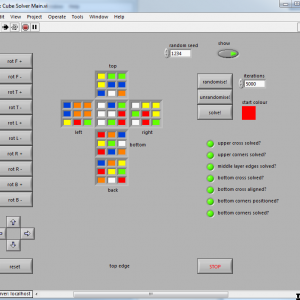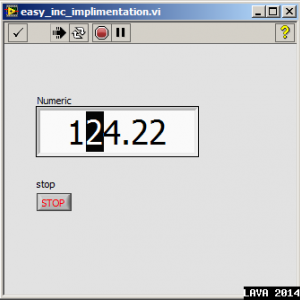*Uncertified*
Post code here that is not ready for certification. Once it is ready for certification please notify the moderators. It will then be moved to the proper category.
78 files
-
Apply Icon To VIs Button
By jgcode
Apply Icon To VIs Button v1.0
Copyright © 2010, Jonathon Green; JGCODE
All rights reserved.
Author: Jonathon Green
LAVA Name: jgcode
Contact Info: Contact via PM on lavag.org
LabVIEW Versions:
LabVIEW 2009 only
Dependencies:
None
Description:
This package contains code posted on NI Forums by NI that applies a fix to the Properties Dialog Box of a Library that adds a Apply Icon To VIs button. This button allows you to easily apply a Library's icon to all Member VIs. Previously you would have had to open the Library icon, edit it, apply changes, then re-edit (it back).
This fix is for LabVIEW 2009 only. This feature will be native in 2010.
This package will install files to the labVIEW 2009\resource\Framework\Providers\VILibrary folder
On unistall the original files will be re-installed.
See here to view original post by AQ.
Installation and instructions:
Install package using VIPM.
Open a LabVIEW Project
Add a new VI to the project
Create a new Library
Add the VI to the Library (note - the VI's icon will not include the Library's banner)
Open the Library's Properites Dialog Box
Press the new "Apply Icon to VIs" Button
The VI's icon will have updated with the the Library's icon
Close the Properties Dialog Box
Examples:
No Examples
Known Issues:
No known issues.
Acknowledgements:
Aristos Queue
Thomas Sandrisser
Version History (Changelist):
1.0-1 2010 06 12
- New (): Initial public release of the code (LabVIEW 2009)
License:
Copyright © 2010, National Instruments
Support:
If you have any problems with this code or want to suggest features:
please go to lavag.org and Navigate to LAVA > Resources > Code Repository (Certified) and search for the Apply Icon To VIs Button support page.
Distribution:
This code was downloaded from the LAVA Code Repository found at lavag.org
836 downloads
Updated
-
IE 2009 Update
By jgcode
IE 2009 Update v1.0
Copyright © 2010, Jonathon Green; JGCODE
All rights reserved.
Author: Jonathon Green
LAVA Name: jgcode
Contact Info: Contact via PM on lavag.org
LabVIEW Versions:
LabVIEW 2009 only
Dependencies:
None
Description:
WARNING: This patch is cannot be unistalled.
This package is a repack that contains code posted on NI Forums by NI that applies a fix to the Icon Editor 2009. This was a large patch that fixed a number of CARs. However, this update was not included in the LabVIEW 2009 SP1 release.
This package will install files to the labVIEW 2009\resource\plugins\NIIconEditor folder
In particular, the following CARs are addressed in this service pack:
See here to view the original document and code posted in the Enhanced Icon Editor Group.
151661
This change fixes the copy/cut ability of the icon. If a region is selected and/or a layer is selcted, copy and cut is enabled.
161032
No limit on arrow keys moving text
175010
When moving a selction and changing a layer, the operation is performed on the new layer
179582
Glyph layer moves after deleting a selection (first edit to the layer)
179799
If the bottom layer got deleted, the user layers list is not updated properly
179392
Icon editor open on secondary screen when working with two screens
179000
Switching the tab doesn't actually unselect the layer
179001
CTRL - A followed by pressing the delete key doesn't delete all selected layers
179007
The key binding is messed up. The mirror tool has set as the toggle key, whereas the OK button should have to set the focus.
179179
Control activates dropper and not move tool when pasting an image
180161
It is possible that multiple icon layers are copied in reverse order and neither template nor text layer are considered at all
182276
Icon glyphs do not handle standard transparency
182828
Manual User Input.vi - OK button doesn't stop the while loop
182893
Paste/Cut of text doesn't update the icon text
182992
Populate Tree.vi can not handle folder with a dot in its name
186982
[iE] Wrong Icon is loaded in Icon Editor
Installation and instructions:
Install package using VIPM.
Restart LabVIEW
Examples:
No examples.
Known Issues:
No known issues.
Acknowledgements:
Thomas Sandrisser
Version History (Changelist):
1.0-1 2010 06 12
- New (): Initial public release of the code (LabVIEW 2009)
License:
Copyright © 2010, National Instruments
Support:
If you have any problems with this code or want to suggest features:
please go to lavag.org and Navigate to LAVA > Resources > Code Repository (Certified) and search for the IE 2009 Update support page.
Distribution:
This code was downloaded from the LAVA Code Repository found at lavag.org
774 downloads
Updated
-
String To Hex Array
this is a very simple LabVIEW code... but i'd like to share this to my fellow LabVIEW developers... this code will convert hex string to a U8 array hex format.. please let me know if you have question or suggestion on this VI. Thanks, Sherwin Tiongson
1,353 downloads
Updated
-
Library And Class Icons
By jgcode
Library and Class Icons v1.0
Copyright © 2010, Jonathon Green; JGCODE
All rights reserved.
Author: Jonathon Green
LAVA Name: jgcode
Contact Info: Contact via PM on lavag.org
LabVIEW Versions:
LabVIEW 2010 only
Dependencies:
None
Description:
This package contains code posted on NI Forums by NI that applies a fix to the VIs in the Enhanced Icon Editor. VI passwords have been removed!
This fix is for LabVIEW 2010 only.
This package will install files to the labVIEW 2010\resource\plugins\NIIconEditor\Support folder
On uninstall the original files will be re-installed.
See here and here to view original document and post by AQ.
Installation and instructions:
Install package using VIPM.
Examples:
No examples.
Known Issues:
No known issues.
Acknowledgements:
Aristos Queue
Version History (Changelist):
1.0-1 2010 08 28
- New (): Initial public release of the code (LabVIEW 2010)
License:
Copyright © 2010, National Instruments
Support:
If you have any problems with this code or want to suggest features:
please go to lavag.org and navigate to LAVA > Resources > Code Repository (Certified) and search for the Library and Class Icons support page.
Distribution:
This code was downloaded from the LAVA Code Repository found at lavag.org
406 downloads
Updated
-
New Accessors
By jgcode
New Accessors v1.0
Copyright © 2010, Jonathon Green; JGCODE
All rights reserved.
Author: Jonathon Green
LAVA Name: jgcode
Contact Info: Contact via PM on lavag.org
LabVIEW Versions:
LabVIEW 2010 only
Dependencies:
None
Description:
This package contains code posted on NI Forums by NI that applies a fix to the New Accessors folder. All VI passwords have been removed!
This fix is for LabVIEW 2010 only.
This package will install files to the labVIEW 2010\resource\Framework\Providers\LVClassLibrary\NewAccessors folder
On uninstall the original files will be re-installed.
See here and here to view original document and post by AQ.
Installation and instructions:
Install package using VIPM.
Examples:
No examples.
Known Issues:
No known issues.
Acknowledgements:
Aristos Queue
Version History (Changelist):
1.0-1 2010 08 28
- New (): Initial public release of the code (LabVIEW 2010)
License:
Copyright © 2010, National Instruments
Support:
If you have any problems with this code or want to suggest features:
please go to lavag.org and navigate to LAVA > Resources > Code Repository (Certified) and search for the New Accessors support page.
Distribution:
This code was downloaded from the LAVA Code Repository found at lavag.org
407 downloads
Updated
-
Icon Editor API
By jgcode
Icon Editor API Repack Extended.
The original Icon Editor API has been recompiled to User.lib. This code makes calls to v.i's/.ctl's in the Icon Editor plugin directory which is not of a symbolic path. This may lead to linking issues and therefore the API was extended to accommondate this.
The Icon Editor API has been extended to provide additional functions such as Class Library Refnum wrappers, Global Stores and helper VIs.
See http://decibel.ni.co...t/docs/DOC-8647 for the source code of the Icon Editor API. Code snapshot taken as of 15/05/10. Note: This original Icon Editor API code be updated by NI in the future.
The password for the Extended Icon Editor API Library is "jgcode".
1,084 downloads
Updated
-
LVMergeHG
By klessm1
Copyright © 2011, G System Solutions LLC
All rights reserved
Author:
Michael Klessens
Contact Information:
PM on LAVA
Issue Reporting or Feature Requests:
http://gsystemsolutions.fogbugz.com
Report under LVMergeHG project
Note:
Due to the nature of this package it does not contain source code (it will not run as source code). For those interested in obtaining the source code for their own builds please contact me via PM and I will point you to the location of a public mercurial repository.
Description:
LVMergeHG will enable users to perform multiple file merges with Mercurial either directly or through a client like TortoiseHG.
It is configured as an external merge program for LabVIEW files that can be merged with LabVIEW's built in merge tool (LVMerge).
Features:
1. Mercurial waits for an external merge program to exit before it will continue to the next merge item. LVMerge exits and launches a separate merge utility before a merge is completed. LVMergeHG acts as a buffer between Mercurial and LVMerge and waits until the LabVIEW merge is complete before it closes.
2. Mercurial downloads merge files in directories other then the target directory. LVMergeHG moves the temporary files into the target directory and removes them when finished. Note: This feature may not be needed if separating compiled code from source in LabVIEW.
3. LVMerge does not handle a two way merge automatically. LVMergeHG asks the user to pick which version (mine or theirs) to use as a base version and uses the selected items when calling LVMerge.
4. LVMerge does not auto select the version of LabVIEW to use for merging the vi's selected. LVMergeHG tells LVMerge which version to use based on the version used to last save the vi.
If the exact version is not found LVMergeHG will find the next highest version of LabVIEW to use. ***See caveat 4 below.
Requirements:
1. LVMergeHG uses LVMerge so a LabVIEW license that supports LVMerge is required (LabVIEW Professional Development System and above).
Recommendations:
1. Install Mercurial first. LVMerge installation will try to configure LVMergeHG's settings on installation, but it can be reconfigured at any time using ConfigureLVMergeHG.
2. Set VI settings to remove compiled code from source. LabVIEW won't require sub vi's to be present at the time of merging when this is set (no search windows).
Caveats:
1. LVMergeHG does not override some of Mercurial's automatic merge decisions.
For example:
You have a vi in one branch that hasn't changed since the base and you deleted it in another branch.
You merge the two branches and Mercurial will assume you want to delete the file without asking because that is the only change.
LVMergeHG sets the premerge configuration to false, although this doesn't seem to effect this merge decision.
Solution is still in development.
2. LVMergeHG is only supported on Windows Operating systems (XP, VISTA, Windows7).
3. LVMergeHG has only been tested with LV2010 although it will most likely work in other versions.
4. LVMergeHG tries to set the version of LabVIEW that LVMerge will use based on the version read from the vi.
However if two versions of LabVIEW are open LVMerge doesn't seem to load the compare in the correct version.
It is safest to only have the version of LabVIEW open that you want to use or not have any version of LabVIEW open.
1,531 downloads
Updated
-
OpenG Config XNodes
By GregSands
These XNodes wrap the OpenG Variant Config routines so that clusters are automagically returned as themselves rather than as variants. The XNodes simply call the OpenG routines, as I didn't want to have to worry about handling (or rewriting) the reentrant algorithm used.
XNodes are provided for Read/Write INI Cluster, Read/Write Section Cluster, and Read/Write Key, and should work as direct replacements.
Many thanks to Gavin Burnell for his extremely helpful toolkit, and his release of Array XNodes which provided the inspiration for trying my first XNodes. I also use a modified version of the XNode Manager by Aitor Solar to create the initial XNodes.
All the usual caveats apply when using XNodes - i.e. don't, unless you know what you're doing, or don't care what happens!
Dependencies:
oglib_variantconfig >= 2.7-2
lava_lib_labview_api_scripting_tools >= 0.22.2.22
437 downloads
Updated
-
ClearCase API
By dannyt
ClearCase API v1.0.0
Copyright © 2011, Danny Thomson
All rights reserved.
Author: Danny Thomson
LAVA Name: Dannyt
Contact Info: Contact via PM on lavag.org
LabVIEW Versions:
LabVIEW 2010
Dependencies:
oglib_string v2.6-1
oglib_file v3.0.1-1
Description:
The API provides an interface to communicate with the CleaCase source control tool.
This API is not meant as a integrated ClearCase provider in LabVIEW.
Installation and instructions:
Installation is performed by VIPM, after which a palette is created in the user.lib palette.
sourcecode can be found here BitBucket
Examples:
No examples are included
Known Issues:
This package only supports Windows ClearCase clients and only supports Base ClearCase no UCM is supported at present.
Acknowledgements:
Thanks to Ton Plomp for inspiration with his Mecurail API
Version History:
v1.0.0: Initial release of the code.
License:
BSD (Most common)
Support:
If you have any problems with this code or want to suggest features:
please go to lavag.org and Navigate to LAVA > Resources > Code Repository (UnCertified) and
search for the "" support page.
Distribution:
This code was downloaded from the LAVA Code Repository found at lavag.org
Some Details of functions provided
=================================
Supports Windows only, though most of the Cleartool commands and options are the same on Unix
Assumes default instilation of ClearCase working with Dynamic Views
If ClearCase is NOT installed in default location then you can manually alter install location in ClearToolPath.vi
Two types of methods
1) VI using ClearCase Cleartool command line all named *_ct.vi
2) VI using the ClearCase Automation Library (CAL) all named *_cal.vi
No interface currently provided for UCM ClearCase operations
Add.vi
========
This VI will add an element or directory to Clearcase ie create a new ClearCase Object.
NOTES
1 The Parent Object (directory) must be a ClearCase Object
2 The Parent object will automatcially be checkedout if it is not already checkedout
3 By default both the parent dir and the added object will be left checkedout
4 If adding a file, the file must already exist
5 If adding a directory , the directory must NOT exist, remember to set Directoy? to true
A creation comment can be added Comment.
Copyright 2011 - Danny Thomson
No waranty included
BranchInfo.vi
=============
This Vi checks if the Branch Name passed in exists in the VOB specified by a Valid VOB Object and if it does it will return the following information.
branch exist? true / false
locked state? True (locked) False (unlocked)
branch description Branch creation comment
obsloete? True (locked & obsolete) false (just locked)
Note only the supplied VOB is checked branch could exist in other VOBs
uses Cleartool command describe -type brtype with formating options
Copyright 2011 - Danny Thomson
No waranty included
CheckIn.vi
====================
This VI will attempt to checkoutin a ClearCase Object (file or folder).
uses ClearTool --- uncheck/out | unco [ –kee/p | –rm ] { –cact [ pname ... ] | pname ... }
–kee/p
Preserves the contents of the checked-out version under a file-name of the form element-name.keep (or, to prevent name collisions, element-name.keep.1, element-name.keep.2, and so on).
–rm
Does not preserve the contents of the checked-out version. Thus, any edits that had been made to the checked-out version are lost.
NOTE. Error -2904 if files in not checked out
Copyright 2011 - Danny Thomson
No waranty included
CheckOut.vi
=================
This VI will attempt to checkout a ClearCase object (FIle or Folder).
INPUTS
----------
FileName & Path itme to be checked out can be file or floder
Checkout comment A checkout comment
checkout Type see below
CC Branch A optional branch to checkout on e.g \main \main\dev\ats\111 see below
uses ClearTool
checkout | co [ –res/erved ] [–unr/eserved [ –nma/ ster ] ]
[ –out dest-pname | –nda/ ta ] [ –pti/me ]
[ –bra/nch branch-pname | –ver/sion ] [ –nwa/rn ]
[ –c/omment comment | –cfi/le comment-file-pname | –cq/uery | –cqe/ach
| –nc/omment ][ –q/uery | –nq/uery |–use/hijack ] pname ...
–res/erved
Reserves the branch: no user in another view can perform a reserved checkout of the same branch (but any number of unreserved checkouts can be performed); no new versions can be created on the branch until your checkout is changed to unreserved with unreserve or resolved with checkin or uncheckout. If you specify both –reserved and –unreserved, this command performs a reserved checkout if possible; otherwise, an unreserved checkout.
–unr/eserved [ –nma/ster ]
Leaves the branch unreserved; other users, in other views, can check out the same version (but at most one of the checkouts can be reserved).
CC BRANCH
Default - blank. View Config specifications rules will be applied.
This allows a specific branch to be used to be used to checkout the file. NOTE branch must in this case MUST be the full branch path ie \main\dev-ats-456 not the branch type dev-ats-456. If CC Branch is used the CC warning messages are suppresed as they WILL occurs, but do not indicated we have have a problem, the branch used MUST EXISTS for the objects being checked out
Copyright 2011 - Danny Thomson
No waranty included
CreateBranchType.vi
===================
This VI will create a new ClearCase Branch Type
Uses CAL
Copyright 2011 - Danny Thomson
No waranty included
CreateLabelType.vi
===================
This VI will create a new ClearCase Label Type
NOTE Label Type Names cannot have spaces in them, else they will be invalid
Uses CAL
Copyright 2011 - Danny Thomson
No waranty included
FileInfo.vi
=================
This Vi finds information on the ClearCase element & version matching the input File or Folder
Outputs
----------
View Private File True if item is not a ClearCase Object other outputs are only valid IF this is FALSE
Labels List of Labels applied to this element. Label (0) is latest label
Flags
IsCheckedOut -- True / False
IsLatest -- True / False
General Info
Branch -- associated branch for file
Extended Pathname -- full ClearCase exteneded pathname ie test.vi@@/main/dev-ats-345
identificer -- see above the bit after ther @@
comment -- if checked in checkin comment else shows checkout comment
using CAL
Copyright 2011 - Danny Thomson
No waranty included
FilesOnBranch.vi
=====================
This Vi lists files on the clearcase branch Branch Name provided.
This VI needs a path to a Valid VOB Object to work.
Default is for Output paths to be Absolute Pathnames using the Windows Mapped Drive. This can be change using the Return Path Type input
Output Cluster
- Total Files on branch
- LabVIEW files on branch ie llb, vi, vit, ctl
- Directories on branch
- Other files On branch
uses ClearTool
find pname -all -nxname -visible -version "brtype(%s)" -print
NOTE. This VI does NOT check the branch exists, such a check should be run first CtViewExists.vi
Copyright 2011 - Danny Thomson
No waranty included
GetConfigSpec.vi
=====================
Gets the ClearCase View Configuration Spec for the View specified ViewTag
Uses ClearTool -- catcs -tag
Copyright 2011 - Danny Thomson
No waranty included
GetViewTagAndCSpec
=====================
This Vi will get the ClearCase ViewTag & releated View Configuration Spec
valid for the provide file or folder
Uses ClearCase Automation Libray
Copyright 2011 - Danny Thomson
No waranty included
LabelFiles.vi
==============
This VI will attach a already created Label Type to the version of the current directory selected by your view,
and to the currently selected version of each element in and below the current directory.
Uses CAL
Copyright 2011 - Danny Thomson
No waranty included
ListBranchTypes.vi
===================
This VI will provide a list of all the Branch Types in a VOB
This VI can take a long time if there are many branches in the VOB !!!!!
using CAL
Copyright 2011 - Danny Thomson
No waranty included
ListCheckOuts.vi
=======================
This Vi finds Checkedout files in the VOB selected by the
File Or folder in VOB input
Output
----------
2-D arrray listing checkedout files
Columns are PathName - View checkedout in --- branch checkedout on -- user checkedout to
using CAL
Copyright 2011 - Danny Thomson
No waranty included
ListLabelTypes.vi
=================
This VI will provide a list of all the Label Types in a VOB
This VI can take a long time if there are many Labelss in the VOB !!!!!
using CAL
Copyright 2011 - Danny Thomson
No waranty included
ListPrivateFiles.vi
========================
This Vi lists the view private files in the VOB and View specified
Inputs
-------
Valid VOB Object Specify VOB
ViewTag Specify ViewTag
Include Checkouts ?(F) If True Checkedout files will be included in results else they will be ignored
Default is for Output paths to be Absolute Pathnames using the Windows Mapped Drive. This can be change using the Return Path Type input
Output Cluster
- Total Files on branch
- LabVIEW files on branch ie llb, vi, vit, ctl
- Directories on branch
- Other files On branch
uses ClearTool
cleartool lsp·rivate [ –tag view-tag ] [ –inv·ob vob-selector ] [ –l·ong | –s·hort ]
[ –siz·e ] [ –age ] [ –co ] [ –do ] [ –oth·er ]
NOTE. This VI does NOT check the branch exists, such a check should be run first CtViewExists.vi
Copyright 2011 - Danny Thomson
No waranty included
SetConfigSpec.vi
====================
Set the ClearCase View Configuration Spec for the View specified ViewTag
Input
-------
Filename Text File that supplieds the view config spec
Uses ClearTool -- setcs -force filename.txt
No waranty included
UndoCheckOut.vi
--------------------
This VI will attempt to undo a checkout on ClearCase File.
uses ClearTool --- uncheck/out | unco [ –kee/p | –rm ] { –cact [ pname ... ] | pname ... }
–kee/p
Preserves the contents of the checked-out version under a file-name of the form element-name.keep (or, to prevent name collisions, element-name.keep.1, element-name.keep.2, and so on).
–rm
Does not preserve the contents of the checked-out version. Thus, any edits that had been made to the checked-out version are lost.
NOTE. Error -2904 if files in not checked out
No waranty included
ViewExists.vi
-----------------
This Vi checks that the VIEW specified by the supplied View Tag exists
Using ClearTool --- lsview
No waranty included
911 downloads
Updated
-
HTML Report Embedded images
By Ton Plomp
This class adds a special version for the HTML-report generation VIs.
By using this class you can use the normal report generation functions, however images will be embedded in the HTML file inside the <IMG> tag.
This tool adds a special override class for the Report Generation toolkit. With this class come 3 overrides for the following functions:
Append Control Image to report
Append Image to report (path)
Append Image to report (string)
These functions allow you to embed the added image into the HTML IMG tag. With this functionality it's possible to generate HTML reports that can be shipped without depending on a file-layout or web-server.
The included DEMO VI shows you how to use this class (only the initiate function is required), and loads a sample file into your default web-browser.
597 downloads
Submitted
-
Submitted
-
Multiple File Path Control
By David_L
This Multiple File Path Control is similar to the default File Path Control in LabVIEW 2011, however you can select more than one file at a time. The data type on the block diagram is an array of File Path Control.
Right click on the MFPC to have it display the full paths or just the file names.
I'll try to post this in pre-2011 but because it uses silver controls, I'll have to make some significant changes.
638 downloads
Submitted
-
Mercurial Provider
By Ton Plomp
This toolkit allows you to directly communicate with you Mercurial repository, from within the LabVIEW project environment.
This toolkit acts as an extension of the supplied LabVIEW SCC interface in LabVIEW professional.
The toolkit allows you to commit, push, tag changesets. Has support for adding Issue tracking IDs.
398 downloads
Submitted
-
Waveform Class
By cvis
LabVIEW Versions:
2010 SP1
Dependencies:
None
Description:
This is a reference based class for handling waveform data. The waveforms are pre-allocated for faster access. Methods allow you to append new waveforms, read the existing waveforms, read a subset of the existing waveforms, or read a decimated copy of the existing waveforms.
453 downloads
Updated
-
A microsecond accurate timer for Labview in Windows
By jcnossen
Since the standard Tick Count VI has very limited resolution, I made a simple timer using the QueryPerfomanceCounter methods in the windows kernel32.dll. The output is the time in seconds as a double precision value.
1,179 downloads
Submitted
-
Move_Cursor_with_Scroll_Key
Copyright © 2012, Prabhakant Patil
All rights reserved.
Author: Prabhakant Patil
Contact Info: Contact via PM on lavag.org
LabVIEW Versions: 2012
Dependencies:
1. LabVIEW Runtime engine 2012
Description:
This example will help you to scroll graph cursor with scroll keys ( UP, Down. Left, Right)
Support:
If you have any problems with this code or want to suggest features:
please go to lavag.org and Navigate to LAVA > Resources > Code Repository (Certified) and
search for the "Move_Cursor_with_Scroll_Key_LV2012" support page.
Prabhakant
302 downloads
Submitted
-
filter specific range of color
By PBJ
This function filters blue pixels.
I have used HSL.
336 downloads
Updated
-
Toolbar XControl
By gb119
lavag_lib_User_Interface_XControls_Toolbar XControl v1.0.0.3 by University of Leeds
Author: Gavin Burnell
Copyright: Copyright © 2013, University of Leeds
License: BSD
Compatible LabVIEW Versions: >= 2012.
Compatible OS Versions: ALL.
Description:
This is a native toolbar for LabVIEW implemented as an XControl. It supports a single row of square buttons which maybe latching (sticky) or transitory (command) style buttons drawn in one of 4 different styles (system, square, flat or rounded). The toolbar will report button clicks via a value change event, but allows the possibility for further integration into other messaging systems.
The buttons are represented as instances of a button base class that provides methods for drawing the button, updating tooltip text or responding to clicks. Overriding these methods in subclasses allows a greate flexibility of response. Included in the package is a 'vi-button' class that stores a vi reference with each button and executes it when clicked.
This Package depends on these other packages:
oglib_string >= 4.1.0.12
1,063 downloads
- user interface
- xcontrol
- (and 1 more)
Updated
-
Wire And Connect Quick Drop Plugin
By bbean
This Quick Drop (QD) plugin complements the functionality of the built-in QD plugin (CTL-Space-CTL-D) by wiring between selected controls, indicators, constants, and SubVIs.
Default Shortcut - [W] Normal Operation Wires selected nodes in left to right order. Attempts to connect any common unwired terminals in between the far left and right nodes by checking the datatype, Name, or Caption. Holding Shift and the Shortuct: Wires controls to unwired far left Node terminals and indicators to unwired far right node terminals. This is just something I put together as my first attempt at a Quick Drop plugin. Something similar has been done previously to wire the corners of subVIs using the right click framework by user JCC_(SK): RCF Plugin - Wire Nodes by Corner - https://decibel.ni.com/content/docs/DOC-8386 . Code for this plugin was developed prior to knowledge of the JCC_(SK) RCF code and probably doesn't function as well since it hasn't been tested thoroughly. However this plugin is for quick drop and has some added capability to wire up all like terminals but can suffer from potential overzealous wiring. Just delete extra wires if necessary. Thanks to the NI guys for creating the QD template with good instructions. Someone may have done this already but I'm putting this out for comment anyway. <a href="http://www.screencast.com/t/PZhMafM2">WireAndConnectVideo</a> http://www.screencast.com/t/PZhMafM2
191 downloads
Submitted
-
LU Solver
By bsvingen
A native Labview (wire) general real matrix solver.
Based on BLAS (FORTRAN code included)
154 downloads
Submitted
-
moderator1983
By Breakpoint
MSDN Link: GetDriveType function
114 downloads
- get drive type
- drive info
- (and 1 more)
Submitted
-
Labview <-> Google maps VI
By Gribo
Connects to google maps javascript V3 api using the web browser .NET object (it exposes the HTML DOM model, where as the ActiveX control does not). This is an improvement over the examples from NI, as it allows dynamic adjustments to all of the map objects. Currently, only circle and marker are implemented.
2,253 downloads
Updated
-
LabView <-> google maps websocket interface
By Gribo
A simple bi-directional interface between Labview and Google maps, using Websocket.
See readme.txt for instructions.
3,979 downloads
Updated
-
Rubiks Cube Solver
By Neil Pate
This project is a 100% G based Rubiks Cube solver that I coded quite a while ago (2007) and then forgot about. I must have saved it it more recently in LV2011.
The algorithm is based on the 7-step method, which is totally sub-optimal for solving a cube, but relatively simple to understand.
Please note this code is not representative of my current coding ability, I just upload it in case anybody is interested.
If I get time I would like to do a 3D representation of the cube and allow the manipulations to be done in this view.
Run instructions:
set the show boolean to True click randomise! pick a start colour click solve! The buttons on the left hand side can be used to do manual manipulations of the cube.
5,096 downloads
Updated
-
easy increment
By tylertroy
I have always found it frustrating that I cannot efficiently change numerical values with the mouse only. This is especially true when I'm simultaneously looking at a gauge on the other side of the room and changing values with my wireless mouse.
"easy increment" selects individual decimal place values by moving the mouse across the spacial extent of a numerical control. Mouse wheel scrolling may then be used to to modify these values.
It's easier to use than explain, I promise!
152 downloads
- interface
- useability
- (and 1 more)
Submitted

